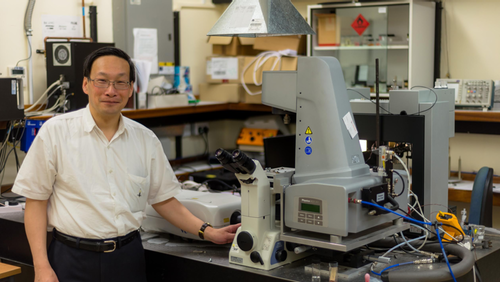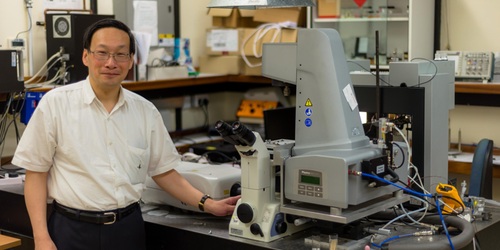Q&A: Try It—It Might Work
Experimental physicist Wilson Poon is a self-described kid at heart, who enjoys “mucking about” with stuff, hopefully without causing an explosion. Originally from Hong Kong, Poon moved to the UK at the age of 17 and never left—the winters, it turned out, were easier to survive than he'd thought. As a professor at the University of Edinburgh, Poon researches the behavior of soft materials, from kitchen-cupboard staples like cornstarch and chocolate to swimming bacteria. He then uses this knowledge to tune and tweak these same materials for specific applications, or simply to satisfy his curiosity. Physics met up with Poon in his lab at Edinburgh to find out more about why soft matter captures his interest.
–Katherine Wright
What project currently has your attention?
I’m excited about shear thickening, where rapid stirring turns a fluid, such as cornstarch particles suspended in water, into a rigid solid. Cornstarch is used so often in popular demonstrations that I naively thought the cause of shear thickening must be understood. But there’s been a long-standing controversy over whether contact forces like friction or noncontact forces like fluid drag are behind shear thickening. Our recent experiments suggest that it’s friction, and that shear thickening is triggered by pressing the particles together. The exciting thing is that this finding is directly applicable to industries that work with particle suspensions because shear thickening can jam, or even break, machines.
What other systems interest you?
I also work with bacteria. I develop model systems to study their collective properties: We want to put many thousands of swimming bacteria together and watch what they do.
It’s difficult to keep a high concentration of bacteria swimming because the cells eventually run out of food and oxygen, and slow down. What you want are bacteria that keep going and going. It has taken my team years to establish the conditions for E. coli to swim at a constant speed for a few hours—long enough to actually do controlled experiments.
What else are you hoping to do with bacteria?
E. coli can swim, but they also grow and divide. I am fascinated by the ways growing bacteria self-assemble into colonies with particular shapes. Could I get such a growing colony to assemble into, say, a cube, or some other more complex, shape? I don't know how to do that, or even whether that can be done. But I am half way to scaring myself into thinking that this might be possible!
You’ve spoken about Friday afternoon experiments. What are they?
I learnt this from the book “The Art of Doing Science and Engineering,” by the informatics pioneer Richard Hamming. Apparently, he regularly devoted his Friday afternoons to imagining futuristic ways of doing and using computing.
In this spirit, I say to my postdocs: On Friday afternoon, forget about the project you are supposed to be working on, and do something just for fun. As long as you don’t burn my lab down or spend my entire budget, and your idea doesn’t break the second law of thermodynamics, then do it! If it works, tell me; if it doesn't, no one need know.
What advice would you give to new graduate students?
Science is caught and not taught. It is far more important that you choose the right mentor than exactly the right topic. Obviously if you don't want to do particle physics then don't do particle physics. But within the broad area you want to work in, ask around until you find the best person to “catch” a passion for doing science from. It needs to be someone who can infect you with a life-long love for the subject and guide you through the art of doing science—from posing worthwhile questions to getting that paper published in your dream journal.
Know a physicist with a knack for explaining his or her research to others? Write to physics@aps.org. All interviews are edited for brevity and clarity.





